
We collect basic website visitor information on this website and store it in cookies. We also utilize Google Analytics to track page view information to assist us in improving our website.
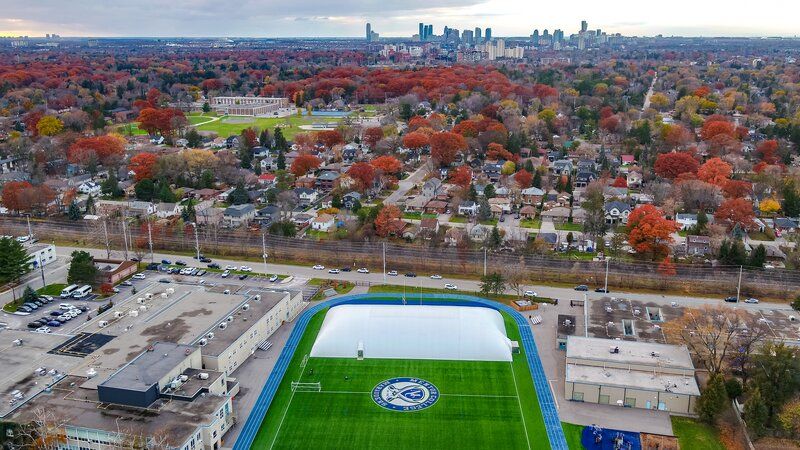
As the weather turns colder and the days shorter, sports lovers grapple with unpredictable weather conditions. The transition from fall to winter can be challenging, not just for athletes and coaches, but also for facility owners, as it impacts the continuity of all kinds of outdoor sports: soccer, tennis, golf, track and field, and other field sports.
However, there's a practical solution to this dilemma: air-supported domes. These domes are a game-changer for seasonal sports. They extend the momentum of summer activities into the fall and seamlessly carry it through the winter's chill.
Under a Farley Dome, athletes can train and compete in comfortable, consistent conditions, regardless of the weather outside. Essentially, domes bridge the gap between fall and winter sports, turning a once challenging period into a seamless, year-round sports experience.
In this blog post, we will talk about the many ways that air-supported domes not only benefit facility operators but also athletes and the broader sports community during the fall-to-winter transition.
The Farley Group has been manufacturing, installing, and servicing sports domes around the world for more than 50 years. Ever since our founder, Ralph Farley, introduced air-supported domes to North America, The Farley Group has led the industry with our commitment to quality and integrity. Our team consists of sales consultants, designers, and highly skilled production and service professionals skilled in all aspects of air structure technology. We’d love to talk to you about your dome project.
Call us or send us a message to get started now!
In Canada and the States, where the weather shifts from mild to harsh unpredictably, transitioning between seasons poses a significant challenge for sports continuity. Sports popular in the summer months often come to a halt in the winter, especially in communities lacking affordable indoor sports facilities.
Warm-weather sports like soccer, tennis, and golf really feel the impact when seasons change. Air-supported domes, however, make transitioning from fall to winter in these sports effortlessly smooth.
The excitement of a soccer game on a crisp fall day can quickly diminish with unpredictable weather. Rain, snow, and cold not only dampen spirits but also disrupt schedules, rendering fields unusable and hazardous. What were once lush, green fields become muddy or icy, increasing injury risks and diminishing the quality of play.
Plus, shorter days limit practice and game time, forcing players and coaches to squeeze in activities before nightfall.
Example: Afrim's Sports is the place to be when it comes to indoor soccer in the Albany, New York area! Located at the home of the Bethlehem Soccer Club, this Farley Dome covers nearly 44,000 square feet of indoor turf.
Tennis courts also suffer from seasonal changes. Damage from moisture, cold, and freeze-thaw cycles compromises playing surfaces, making them unsafe and hindering the play experience.
Cold temperatures also affect players and their equipment, with every drop in temperature impacting comfort and performance.
Without indoor alternatives, players lose valuable practice time essential for skill development and competitive edge.
Example: Barrie North Winter Tennis, a division of Tennis Clubs of Canada, is located in Midhurst, Ontario, and consists of 4 tennis courts under a heated, air-supported Farley dome complete with new LED lighting. The Farley Dome is erected in early October, and is taken down at the end of April each year.
Golfers face challenges as driving ranges become less inviting in colder, wetter conditions.
Practicing swings and techniques is harder, and golf gear, like balls, performs differently in the cold, affecting gameplay. This drop in comfort and accessibility leads to reduced player turnout.
Example: The Hastings Fieldhouse Farley Dome features a walking track, soccer field, golf driving range, as well as courts for basketball, ball hockey, and racquet sports. It truly is a multi-functional facility. It includes the capacity to accommodate many varied and unique training activities, as well as clinics and workshops.
Winter poses major challenges for track and field athletes. Outdoor tracks, essential for training, become unusable due to snow and ice. Each event, with its specific training requirements, is disrupted, affecting preparation and performance.
The cold weather also increases the risk of muscle strains and injuries, as proper warm-up becomes more difficult and slippery conditions pose additional hazards.
Example: The Farley Dome at University of Alberta's Foote Field is the largest, air-supported dome structure in all of Alberta, turning the seasonal field into a year-long training facility. It includes a multi-lane, 140 meter track with a jump pit available to the track and field community of Edmonton.
Each year, facility owners and operators face the challenging transition from fall to winter sports. This is where air-supported domes, particularly Farley Domes, come into play. Our domes are designed to help make manging sports facilities straightforward and efficient, regardless of the season.
One of the standout features of our domes is their rapid setup. They can be erected in just a day or two, minimizing downtime and keeping the sports schedule on track. This speed is a lifesaver for places that need to switch from open-air to indoor settings quickly when the weather changes.
Timing is everything here. Facility owners can time the dome set-up right at the end of the fall season. This means no awkward gaps — just smooth sailing from outdoor to indoor sports. It's this kind of scheduling smarts that helps get the most out of facilities all year round.
The ability to control the climate inside these domes is a significant advantage. Owners can dial in the perfect temperature, making it comfy for both players and fans. This matters a lot when you're moving from the mild fall to the chilly winter.
Stable conditions are key for sports where the weather really affects the game. Domes keep things consistent, offering the best setting for sports, come rain or shine.
Energy efficiency is another big plus. These domes use smart heating and cooling, keeping costs down, especially in the colder months when heating bills can go through the roof.
Domes are champs at handling sudden weather shifts. They can warm up or cool down in no time, crucial for dealing with those unpredictable fall and early winter days. This means the facility stays open and comfy, no matter what Mother Nature throws at it.
These domes also extend playtime. As days get shorter and colder, indoor domes offer a bright, warm spot for evening and night games.
And let's not forget how well they protect against the elements. Wind, rain, snow — domes keep them all out. This means less weather delays and more reliable schedules for teams and facility owners.
With their quick setup, climate control, and weather readiness, they're the perfect choice for facility owners wanting to keep the game going all year long. Choosing a dome isn't just prepping for winter; it's opting for non-stop sports, no matter the season.
For sports facility managers wrestling with tough decisions, choosing air-supported domes is a no-brainer. It's a move toward keeping the action going and growing. Think of it as an investment that pays off in more ways than one!
Why let the weather dictate another season? Now's the chance to turn your sports facility into a year-round hub of excitement.
We've all been there — the nail-biting worry of whether an early frost or a sudden downpour will throw the day's schedule into chaos.
For outdoor sports clubs and businesses, the fall and winter seasons usually means cancelled events, disappointed customers, and yes, a dip in revenue that lasts well into spring.
But it doesn’t have to.
Stay with us as we explore the various ways that a dome helps you turn fall and winter from a stressful slump into one of the best seasons of the year.
Unlock the potential of your sports facility. Contact The Farley Group to understand the opportunities a dome offers.
When you think of indoor sports, you might imagine gymnasiums built from brick and mortar or steel and concrete. But in the world of sports facility solutions, there's something much more futuristic: the air-supported dome.
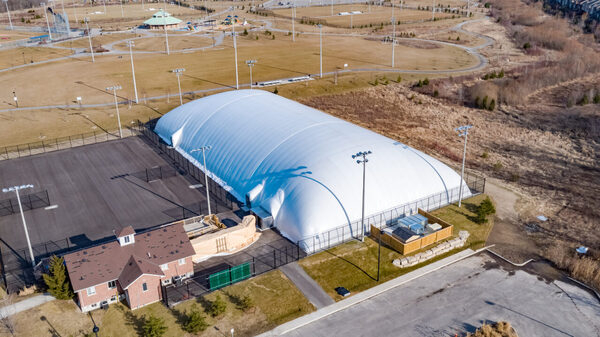
Domes are a marvel of modern engineering. Essentially, a dome is a large "bubble" made of durable, weather-resistant fabrics. This fabric is held up, not by beams or columns, but by a steady stream of air pressure. The result? A vast, open space free from annoying columns or beams, perfect for soccer, tennis, golf, and virtually any other sport you can imagine.
More importantly, air-supported domes are a fortress against bad weather. Whether it's rain, high winds or snow, sports that would normally have to be cancelled can continue smoothly under the protection of a dome.
Plus, their unique construction and flexibility makes domes an incredibly cost-efficient solution. Think of how much steel, brick, and concrete it takes to build an indoor soccer field or driving range — a dome offers the same benefits at a fraction of the cost.
Fall and winter, traditionally seen as downtime for outdoor sports facilities, can become your peak seasons with the right approach. An air-supported sports dome not only shields your space from the whims of weather but offers numerous avenues to scale up, diversify, and unlock untapped revenue streams.
Let's dive into the specifics.
We've all felt the sting of the off-season. Watching a perfectly good field or court sit underutilized, waiting for the next season to roll around… it feels like a missed opportunity.
With a dome, the action doesn't have to stop. Our sports domes feature state-of-the-art climate control to maintain a comfortable temperature and humidity inside even as mercury plummets. As far as snow and rain are concerned? They might as well not exist.
This means that the players, clubs, and sports organizations who book your facility in the warmer months can continue to practice and play into October, November, December...all the way around to next spring, when the dome’s ready to come down until next fall. No gaps.
Think about it – leagues can run longer, training sessions can be more frequent, and events don't have to be crammed into the summer months. To give just a few examples:
* Soccer Training Camps:
* Tennis Tournaments:
* Golf Driving Range:
All these result in higher player satisfaction, as they get more time to hone their skills and engage in the sports they love.
And for you? A significant uptick in revenue, even when the trees are shedding their leaves.
Don’t let the cold keep you down. Extend your sports season and revenue with The Farley Group’s domes.
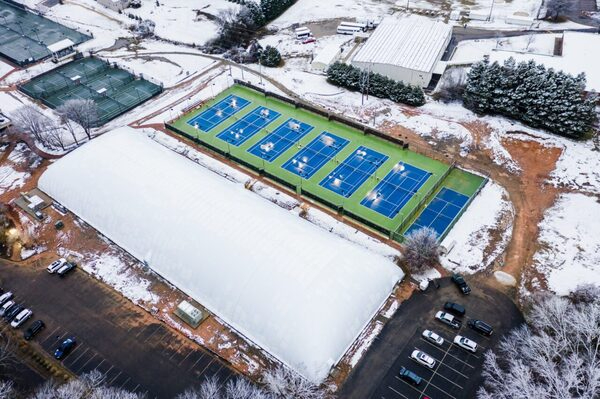
Have you ever found yourself looking at your facility and thinking, "I wish I could do more with this space"? With an air-supported dome, you can!
Every business owner knows the unease of relying solely on one kind of activity or event, especially when unforeseen circumstances can throw a wrench in the plans. The unpredictable nature of weather or seasons can easily affect bookings, causing revenue to fluctuate.
This is the beauty of a dome. Domes aren’t just for sports – they’re incredibly versatile spaces you can easily adapt to accommodate a wide array of activities and events.
Picture hosting fitness classes, from yoga to Zumba. Imagine setting up exhibitions, trade shows, or craft fairs. How about community events, workshops, or even theatrical performances? These are just a few ideas to tap into new customer segments and diversify your revenue.
And the beauty of it? No rain checks. With a dome, you're not just playing the game – you're changing it!
Think about the number of times you've had to cancel or reschedule games or events due to weather. The lost revenue, the disappointment of your clients…it’s beyond frustrating.
For many sports facility owners and managers, the looming threat of bad weather is a constant source of stress. It’s not just about the money, but about maintaining customer satisfaction.
And this isn’t just a fall and winter problem, either. Spring showers and summer storms are just as disruptive.
The great thing about domes is that they don’t have to go up each fall and come down each spring. Permanent domes that stay up year-round are a fantastic option for those who are looking to create true revenue stability.
In a world full of uncertainty (especially when it comes to weather), your dome brings a level of predictability and consistency that both you and your clients will love. Weatherproof your facility with The Farley Group. Learn more about our year-round dome solutions.
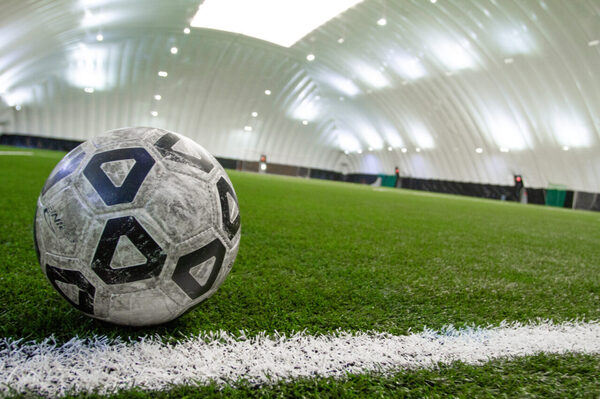
A Farley dome can be your secret weapon to unlock the full revenue potential of the fall and winter seasons. Domes provide a dependable, weather-proof, and customizable environment that transforms outdoor spaces into year-round venues.
Interested in taking the leap or just want more details? Reach out to The Farley Group for more information about our sports domes. Our team is eager to assist and guide you toward a future where your facility stands out, rain or shine!
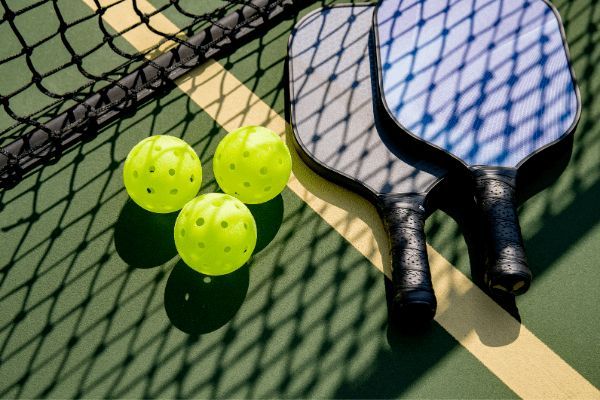
Pickleball: it’s like table tennis without the table. Or, you could say it’s like ping-pong on a tennis court.
However you put it, pickleball is one of the single fastest-growing sports in the world right now. And believe it or not, this is very, very good news for tennis clubs.
In cities across North America, where the demand for pickleball courts has outpaced the infrastructure, tennis clubs are cashing in ‒ just by adding pickleball lines to their existing tennis courts.
Just ask your local court contractor. These days, there’s a good chance they’re spending more time painting pickleball lines than tennis lines!
The market for pickleball just keeps growing. More than 3.3 million Americans played pickleball last year, a 10% increase in three short years. The sport made headlines last summer when it became a viral sensation in the Disney World NBA Bubble.
There’s even a group pushing for pickleball to become an Olympic sport, which could fuel an even greater explosion of interest.
Now, don’t get us wrong: tennis is here to stay. Not even a gold medal could turn pickleball into a replacement for good, old-fashioned tennis.
But for tennis clubs looking to shore up membership revenue ‒ especially in the wake of pandemic lockdowns ‒ bringing in pickleball could be the answer. And you don’t have to sacrifice a single tennis court to make it happen!
Let’s take a closer look at the surprising courtship between tennis and pickleball.
1. Background: What is Pickleball?
2. Pickleball vs. Tennis: What are the Differences?
3. 3 Ways to Add Pickleball Lines to a Tennis Court
Pickleball is a court game that combines elements of tennis and table tennis/ping pong: players at opposite ends of a court, a plastic ball, paddles, and a net. It can be played in singles or doubles.
The popularity of pickleball is usually attributed to its beginner-friendliness. It’s a simple, low-impact sport that new players can pick up the game in an afternoon. Pickleball is especially popular with the “cocktail crowd”: active adults over 55, who have the free time to play in peak and off-peak hours.
But don’t be fooled by its simplicity. Pickleball veterans bat a serious game! Where beginners usually hit the ball back and forth 15 to 20 times on a point, the pros can go for 90 or more.
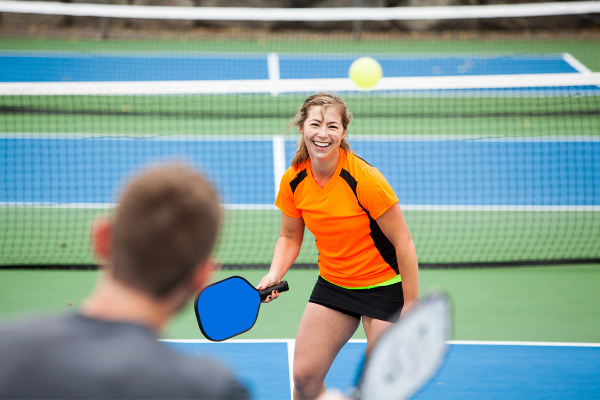
While the two sports have plenty in common, the differences matter when it comes to planning a court.
A tennis court is 78 feet long and 36 feet wide. A pickleball court is much smaller at 44 feet long by 20 feet wide. In tennis, the net is set to a height of 43 inches at the ends and 36 inches at the centre; a pickleball net, on the other hand, should be 36 inches high at the ends and 34 inches in the centre.
Beyond the courts, the differences between tennis and pickleball are obvious. Pickleball is played with a plastic, perforated ball (called a pickleball) and paddle, rather than a tennis ball and racquet. The two sports also have different rulesets.
Now, the uninitiated might be tempted to view tennis and pickleball at odds, but that couldn’t be further from the truth. In fact, some of pickleball’s biggest advocates are current and former tennis players.
Pickleball is a popular “step-down” sport for tennis aficionados who need a change of pace. Many pickleball greats are former tennis players who transitioned to the lower-impact sport later in life.
Despite their differences, tennis and pickleball can easily coexist at the same club ‒ sometimes even on the same courts. With a bit of good planning, tennis clubs can leverage this to redouble their membership revenue.
Here’s the best part: you don’t have to tear up your existing tennis courts to bring in pickleball.
While replacement is always an option, adding pickleball lines to an existing tennis court lets the two sports coexist and gives club management an inexpensive way to gauge interest in pickleball.
Just keep in mind that for sanctioned tennis play, the rules only allow for tennis lines to appear on courts. So, unless you’re prepared to go all-in on pickleball, you’ll want to save your prime courts for tennis tournaments!
There are two ways to add pickleball lines to an existing tennis court:
a. One pickleball court per tennis court
b. Two pickleball courts per tennis court
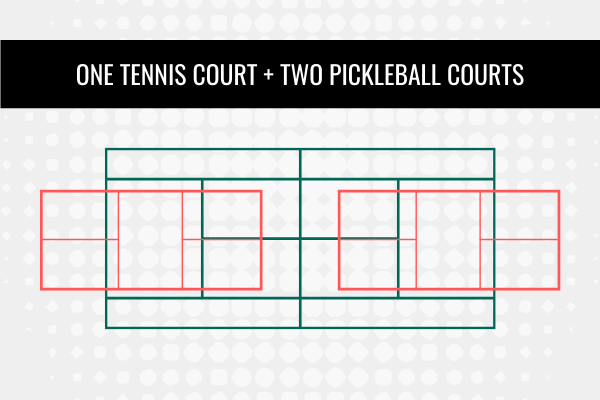
This arrangement utilizes the existing tennis net. Since a tennis net is two inches higher in the centre than a pickleball net, you will have to install tie-downs to lower the net to the correct height. There is a product called the Convert-a-Net designed for this purpose.
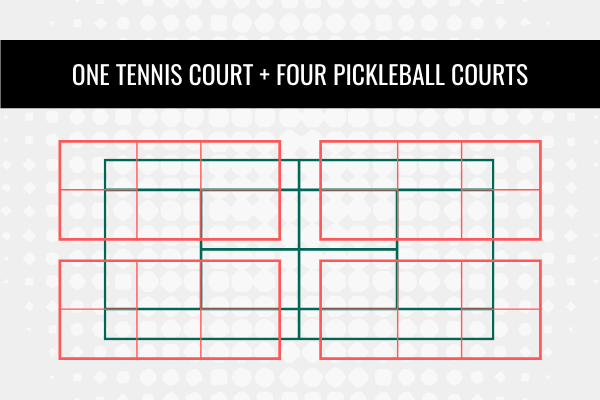
This arrangement allows for two pickleball matches to take place on one tennis court at once. However, it requires that you bring in portable pickleball nets.
Be mindful of the fact that pickleballs are lighter than tennis balls and thus more susceptible to the wind. Having pickleball courts this close together outdoors can lead to balls ending up in someone else’s court!
Truthfully, playing pickleball outdoors has all the challenges as outdoor tennis...especially in the colder months. But with the help of a dome, pickleball can become an all-season sport just as easily! Learn more about the benefits of a tennis dome.
Have the lines installed by an experienced contractor! Tape won’t do the trick. In addition to being unattractive, and almost always crooked, tape can bond with the playing surface over time, becoming impossible to remove without damaging the court.
To make it easier to tell the lines apart, pickleball lines on a tennis court should not be painted white. Pickleball lines should be painted narrower than tennis lines for the same reason.
Since a tennis court is longer than a pickleball court, you might want to install a temporary barrier so that pickleballs don’t have to be chased the full length of the court.
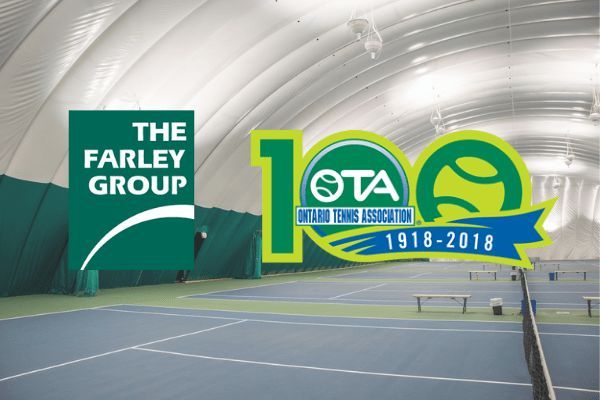
It goes without saying that 2020 has been a difficult year for sport clubs.
But today, we’re happy to share some news that’ll help us build a brighter future for the 250+ tennis clubs across Ontario.
As of October 1st, 2020, members of the Ontario Tennis Association now have access to a resource that could help them bounce back in 2021: a partnership with North America’s 1# Tennis Dome Supplier and Service Provider.
The Ontario Tennis Association (OTA) has announced that The Farley Group is the new Official Tennis Dome Supplier and Service Provider of the Ontario Tennis Association and its over 250 members. Effective October 1, 2020, the 4-year agreement is in place until September 30, 2024.
We can’t wait to lend our air structure expertise, as well as our passion for setting industry standards when it comes to service and support, to OTA members across the province! Here’s what this exciting partnership means for Ontario’s tennis clubs.
If you’ve ever taken or taught tennis lessons in Ontario, you’ve probably heard of the Ontario Tennis Association.
Founded in 1919, the Ontario Tennis Association (OTA) is the governing body for tennis in Ontario. The Ontario Tennis Association is the single largest provincial association within Tennis Canada, with 250 clubs and approximately 75,000 players across the province.
The OTA’s mission is twofold: to encourage participation in tennis as part of a healthy lifestyle, and to promote the pursuit of excellence in the sport for all tennis players.
With those goals in mind, it’s clear why the Ontario Tennis Association and The Farley Group are a perfect fit.
Here are a few important stats.
Today, tennis ranks as the 8th most played sport in the country, with about 6.6 million Canadians picking up a racquet in 2019.
But that number would be much higher if not for the startling lack of indoor tennis courts throughout much of the country.
Amazingly, a whopping 51% of Canadians say they would play more tennis if only they had access to convenient and affordable covered courts nearby!
Right now, only 10% of outdoor tennis courts get covered during the winter...and 85% of those covered courts are located in either Toronto, Montreal, or Vancouver! Millions of Canadians are being left out in the cold.
And this, right here, is where The Farley Group and the OTA can make a huge difference together. Canadians are clamouring for indoor tennis facilities, and tennis domes are the simplest, fastest, most cost-effective way to provide them.
We think tennis domes could be the key to getting more and more people involved in this incredible sport. Who knows ‒ with more tennis domes in Ontario, the number of Canadian players could climb to 7, 8, perhaps even 10 million people!
Truly, the sky's the limit.
Tennis domes (also known as ‘tennis bubbles’, which is the term used by Tennis Canada and others) are incredibly versatile structures that can be designed, constructed, and installed at a fraction of the cost of a brick-and-mortar structure.
Domes can be permanent or seasonal/temporary. You can have a year-round tennis bubble that offers air-conditioned play in the summer and warmth in the winter, or a seasonal dome that covers the court only from fall to spring.
Domes can be used to cover tennis courts, of course, but also soccer fields, pools, driving ranges, velodromes, volleyball courts...practically any sporting arena you could imagine.
We’ve also seen domes used as community spaces like gyms, party venues, and storage facilities! The possibilities are virtually endless.
Now, if you’re used to playing in the great outdoors, you might wonder what it’s like to play tennis in a dome. To be honest with you, it’s hardly any different from playing on a regular court.
Some athletes worry that a dome might feel “stuffy”, but that shouldn’t be the case. The Farley Group’s tennis domes are exceptionally well-ventilated (more on that later) and completely climate controlled for optimal, predictable comfort.
As for the playing experience? The only real difference is that domes will offer a cooler playing temperature during the warmer months than outdoor play, which means the ball will bounce slower than it might outdoors. But the change is so minimal that most players have no problem adjusting!
Here’s why now is the perfect time for this exciting new partnership.
It comes at a time when, in light of COVID-19, the advantages of a dome are more evident and important than ever before.
We know the risk of transmission is generally lower outside than indoors. That’s all well and good when it’s July, but as the temperature falls, so do the prospects of outdoor tennis.
The good news? The air inside of a dome is a lot closer to outdoor conditions than most buildings.
1. The Air Quality In a Dome Resembles Outdoor Conditions.
A typical dome contains 500,000 to 5,000,000 cubic feet of air; for a topical comparison, a typical classroom contains just 6,000 cubic feet of air.
2. Dome Ventilation Is Remarkably Better Than In Most Buildings.
Under ASHRAE standards, a normal classroom’s ventilation is designed to move 222 cubic feet of air per minute; domes have a minimum of 50 times more outside fresh air!
3. There’s Tons of Room To Breathe In a Dome.
At 6-foot social distance, a dome provides about 800 cubic feet of ventilation air per person per minute; a typical classroom with 20 students would provide 11 cubic feet.
In other words, you could say that playing tennis is a dome is the next best thing to playing outdoors!
The Farley Group is proud to be the Official Tennis Dome Supplier and Service Provider to Canada’s largest Provincial Tennis Association. Reach out to us to learn more about what we do or find out how your tennis club can benefit from this exciting partnership!
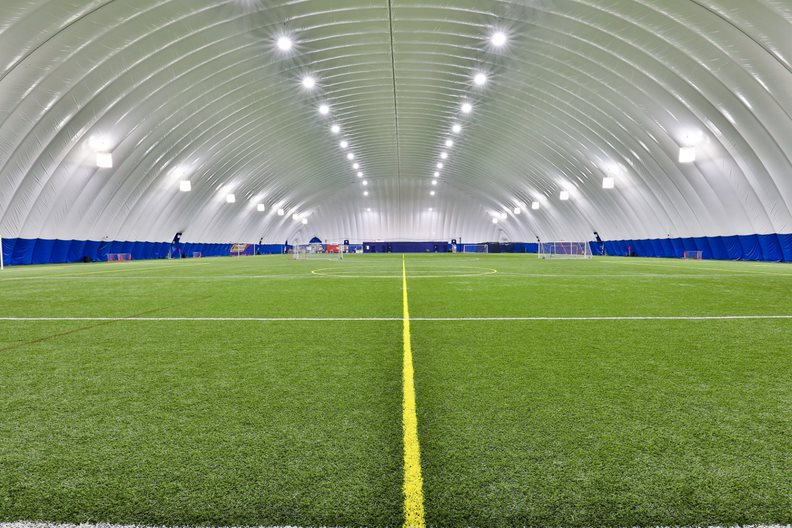
We know that COVID-19 is more easily transmitted in closed areas than outdoors.
Case in point: Restaurants. Indoor dining was one of the first things to go when the pandemic hit, but it wasn’t long before public health experts gave the green light to open-air patios ‒ and the restaurant industry (plus their loyal customer base) was quick to adapt.
Another perfect example? Classrooms. Recent reports from Harvard University and a group of Ontario hospitals have recommended moving classes outside when possible because the risk of transmitting COVID-19 is much lower there.
Since summer, we’ve seen outdoor elementary school classrooms, outdoor fitness classes, even outdoor university lectures.
Problem is, tolerable temperatures for outdoor learning don’t last long in most of Canada and the Northeastern U.S.A., and unfortunately, COVID-19 isn’t going anywhere soon.
But that doesn’t have to mean class is cancelled.
Because ventilation and air flow inside of a dome is close to outdoor conditions, domes are being pegged by some engineers as a solution for cities and educational institutions searching for reliable clean air.
Plus, domes aren’t just safe alternatives to classrooms! Last spring, Columbia University quickly transitioned its upper Manhattan soccer dome into a 288-bed field hospital. And in China, where air quality has long been an issue, domes have been used as safe alternatives to outdoor spaces for years.
“I think everyone understands and agrees that the best alternative is to be outside as far as the COVID-19 situation goes,” said Farley Group president and CEO John Simpell. “But now that everyone is being forced inside, the focus is on finding safe alternatives.”
When it comes to reducing the risk of transmission, being in a dome could be the closest thing to being outside – and the safest way to keep learning, training, and other in-person activities alive over the coming winter.
Read More: “Domes could be a key to keeping activities alive over winter” [Kitchener Record]
